After the Battle of Midway in the summer of 1942, the United States launched a counter-offensive strike known as “island-hopping,” establishing a line of overlapping island bases. As each Japanese-held island fell, U.S. forces quickly constructed airfields and small bases, then moved on to surrounding islands, one after another, until Japan came within range of American bombers.
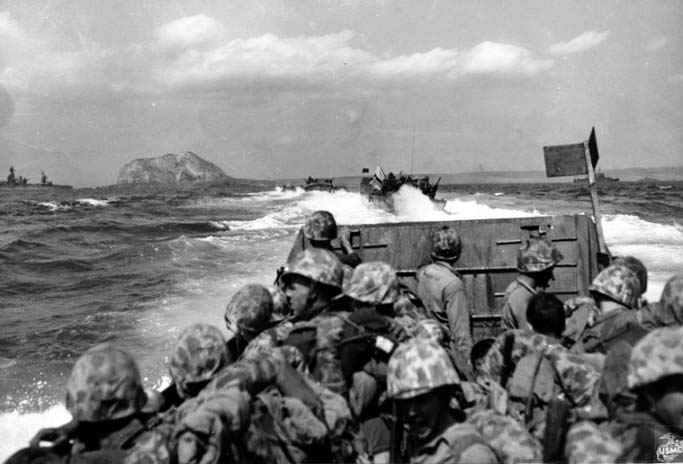
The volcanic island of Iwo Jima was a crucial location for the island-hopping campaign to succeed. The island’s proximity would make it possible for Marianas Island-based B-29 Superfortresses to refuel on their way to bomb Japanese targets and surrounding islands. It was also ideal for bombers damaged during the raids to find safety and medical attention on their way home from bombing Japan. Three airstrips, which the Japanese had been using for their suicidal Kamikaze attacks to destroy U.S. Navy warships, also made Iwo Jima a primary target. With the island captured, the Kamikazes would have to operate from Okinawa or Kyushu.
Preparation to Assault Okinawa
On Feb. 19, 1945, the U.S. Marine Corps’ legendary 3rd, 4th, and 5th Divisions landed on Iwo Jima to provide fixed air bases for B-29 Superfortress air attacks against Japan and surrounding islands. It took 36 days of brutal combat, while literally inching their way across the island, for the Marines to secure Iwo Jima. But victory came at a heavy price. At the battle’s conclusion, 6,281 Americans were killed and 19,217 wounded. The Japanese lost 17,845-18,375 dead and missing.
With Iwo Jima secured, preparation to assault Okinawa in the Ryukyu Islands began to move forward. Okinawa, on the southern tip of Japan, would serve as the perfect base for air operations and training of U.S. forces for the planned invasion of the Japanese homeland-thought to be inevitable. Dubbed “Operation Iceberg,” planning began with Lt. Gen. Simon B. Buckner’s Tenth Army tasked with taking the island.
Initial U.S. landings began on March 26, 1945, when elements of the 77th Infantry Division captured the Kerama Islands to the west of Okinawa. On the 31st, Marines occupied Keise Shima. Only eight miles from Okinawa, the Marines quickly emplaced artillery on these islets to support future operations. The main assault moved forward against the Hagushi beaches on the west coast of Okinawa on April 1. This was supported by a feint against the southeast coast by the 2nd Marine Division. Coming ashore, Maj. Gen. Roy Geiger’s III Amphibious Corps (1st & 6th Marine Divisions) and Maj. Gen. John Hodge’s XXIV Corps (7th & 96th Infantry Divisions) quickly swept across the south-central part of the island capturing the Kadena and Yomitan airfields.
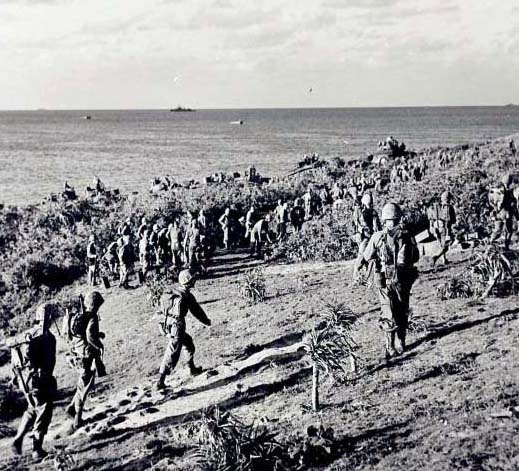
Having encountered light resistance against zero opposition and with almost no casualties, the seasoned combat veterans in the assault force realized that a very hard road lay before them because the Japanese had chosen to dig deep and fight on their own terms.
With the majority of his forces moving south, Gen. Buckner ordered the 6th Marine Division to begin clearing the northern part of the island. Proceeding up the Ishikawa Isthmus, they battled through rough terrain before encountering the main Japanese defenses on the Motobu Peninsula. Centered on the ridges of Yae-Take, the Japanese, under the command of Col. Takehiko Udo, mounted a tenacious defense before being overcome on April 18. Two days earlier, the 77th Infantry Division landed on the island of Ie Shima offshore. In five days of fighting, they secured the island and its airfield.
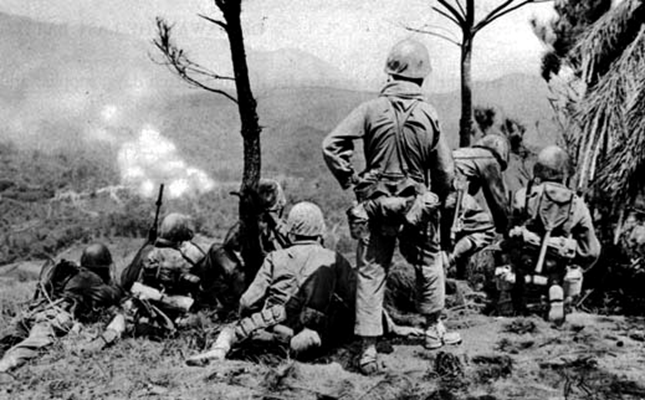
Japanese to Conduct a Fierce Defense of Okinawa Over Many Weeks
Though fighting in the northern part of the island was concluded in fairly rapid fashion, the southern part proved a different story. While Ushijima did not expect to defeat the Allies, he sought to make their victory as costly as possible. To achieve this, he had constructed elaborate systems of fortifications along with a series of defensive lines across the island, both north and south of the American landing beaches, enabling the Japanese to conduct a fierce defense of Okinawa over many weeks. Using pillboxes and strongpoints, caves, and even some ancient castles, the Japanese defensive positions supported one another and often resisted even the most determined artillery fire or airstrikes. Mounting a few attacks themselves, the Japanese conserved their strength for this defense. Caves or pillboxes often had to be destroyed individually with dynamite charges.
Pushing south, Allied troops fought a bitter battle to capture Cactus Ridge on April 8, before moving against Kakazu Ridge. Forming part of Ushijima’s Machinato Line, the ridge was a formidable obstacle and an initial American assault was repulsed.
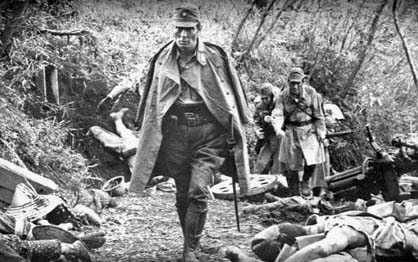
Counterattacking, Ushijima sent his men forward on the nights of April 12th and 14th but was turned back both times. Reinforced by the 27th Infantry Division, Hodge launched a massive offensive on April 19. In five days of brutal fighting, U.S. troops forced the Japanese to abandon the Machinato Line and fall back to a new line in front of Shuri. As much of the fighting in the south had been conducted by Hodge’s men, Geiger’s divisions entered the fray in early May. On May 4, Ushijima again counterattacked, but heavy losses caused him to halt his efforts the next day.
As the Battle of Okinawa worked through its second month, the 6th Marine Division was tasked with moving down the west side of the island to sever Japanese lines and then move eastward behind the heights of Shuri. On top stood the bombed-out, shelled-out ruins of Shuri Castle, the visible part of an elaborate network of tunnels and pillboxes that comprised Ushijima’s main defensive fortifications on the island. Shuri Line was located in hills that were honeycombed with caves and passages, and the Marines had to traverse the hills to cross the line.
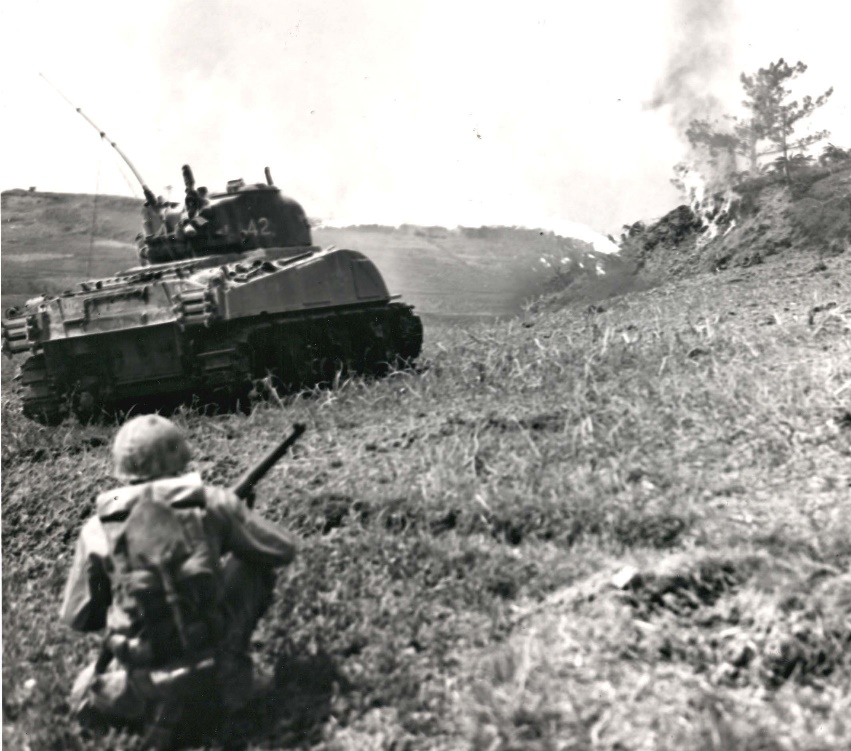
Sugar Loaf Hill, the Main Hill Situated on the Southern End of Okinawa
As the 6th Marines moved forward, orders came down for them to capture the Sugar Loaf Hill Complex, three hills which formed the western anchor of the Shuri Line defense. Sugar Loaf Hill, the main hill, was a small, insignificant-looking mound, barely 50 feet high and about 300 yards long, situated on the southern end of Okinawa. It was part of a triangle of strongpoints set up by the Japanese defenders designed to delay and damage the attacking American forces. The other two points of the triangle were the higher terrain of Shuri Heights and an irregular-shaped set of hills that Marines called the Half Moon.
Leathernecks of Company G, 22nd Marine Regiment were the first to bump heads with the mound and the first to feel the heat of the interlocking fires. By the end of its struggle to take Sugar Loaf, “George” Co. would be down to 24 men of its original complement after taking over 85% casualties. When it was relieved, more units were ordered into the fight and were consumed one by one. Many times, Marines reached the summit of the mound only to be driven off or killed by the murderous fire. Eventually, the realization sank in, that the mound was an interlocking system of caves and tunnels with the firing ports so cleverly disguised as to be virtually undetectable. The tanks being used to support the assaults often fell victim to mines, artillery, and antitank fire. Those who got through were ineffective in taking out the bunkers because of the camouflage.
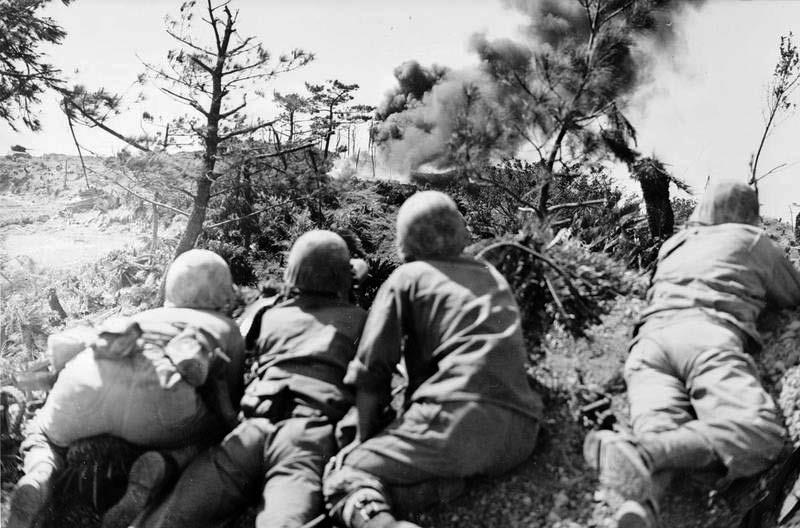
For twelve mostly rainy days, the Marines fought the Japanese over this seemingly insignificant hillock, no more than three football fields in size. On eleven different occasions, the hill was assaulted. Men sprang into action, clamoring up the hill, only to be shelled and shot at with such accuracy and ferocity that they were forced to retreat. It became apparent that all three of these small hills would have to be taken together due to the covering fire each hill provided the others.
May 16, 1945, proved to be an especially trying day, as four times the 6th Marines reached the summit, and four times were driven back. The frustration for the Marines was that the hills they were trying to storm looked like barren little humps covered with tree stumps left by Navy gunfire. There was no outward indication of all the caves and tunnels inside. In fact, most Marines never even saw the Japanese firing at them.
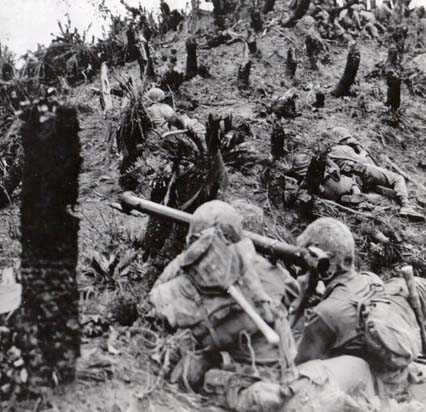
The morning of May 18, 1945, provided the breakthrough. The 1st Marines were able to take Wana Ridge, which housed Japanese 75mm guns used to shell Sugar Loaf. This allowed tanks to be brought in to encircle the hill and to provide suppression along with artillery while Marines worked to dynamite and seal the caves. Ushijima’s efforts to reinforce Sugar Loaf failed under intense American artillery, and the 6th Marines stood atop Sugar Loaf Hill, never to relinquish it.
But the cost was tremendous. Over nearly two weeks, regiments had been reduced to company strength and companies to platoons. Many platoons were wiped out to a man. More than 1,600 Marines died in the fight for this 50-foot-high strongpoint, with another 7,400 wounded.
The fight for Sugar Loaf Hill would come to epitomize the brutal battle of attrition that was the experience not only in the fight for Okinawa but also in many far-flung island battles of the Pacific campaign.
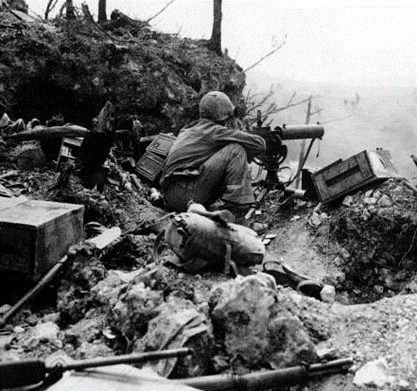
The Battle of Okinawa Had Been Among the Most Brutal of the Pacific War
After Sugar Loaf, the 6th Marine Division advance through Naha conducted a shore-to-shore amphibious assault on the Oroku peninsula where they battled Admiral Ota’s forces for 10 days. The battle on Okinawa ended on June 21, 1945. The 6th Marines were credited with over 23,839 enemy killed or captured, and with helping to capture two-thirds of the island, but at the cost of heavy casualties, including 576 on one day, May 16 at Sugar Loaf Hill-a day described as the “bitterest” fighting of the Okinawa campaign.
One man’s actions stood out on Sugar Loaf Hill: Marine Corporal James L. Day rallied two dwindling squads of men for 3 days, from May 14-17, to hold a shell hole on the hill against repeated and relentless waves of Japanese attacks. By the third day, he had lost all but one member of the two squads to enemy fire and had saved the lives of most of his wounded men by carrying them back down the hill to safety by himself one at a time. He did this while resupplying his shell hole every night with raids on a couple of disabled LVTs at the bottom of the hill, and while providing lethal covering fire for many other Marine assaults on the hill.
Corporal Day and his surviving squadmate, with multiple burns and fragmentation wounds, only abandoned their position when ordered to do so after the third day, to allow a massive bombardment of the complex. He left the bodies of over 100 dead Japanese soldiers stacked within feet of his shell hole, most of whom he had killed himself, many of them in hand-to-hand combat. Corporal Day eventually retired as a Major General. He received the Medal of Honor for that action, but not until nearly 56 years later, and just 9 months before he passed away.
The battle of Okinawa had been among the most brutal of the Pacific War. The commanding generals on both sides died: Lt. Gen. Simon B. Buckner by Japanese artillery fire, Gen. Ushijima Mitsuru by suicide. Other U.S. losses in ground combat included 7,374 killed, 31,807 wounded, and 239 missing in action. The Navy suffered its greatest casualties for a single engagement with 4,907 killed or missing aboard 34 ships sunk and 368 damaged; 763 aircraft were lost. At sea and in the air, the Japanese expended roughly 2,800 aircraft, plus a battleship, a light cruiser, and four destroyers, with losses that can be estimated at upwards of 10,000. More than 150,000 Japanese – many of them civilians – were killed during the battle. Photo is Lt. Gen. Buckner foreground and Maj. Gen. Geiger standing next to him.
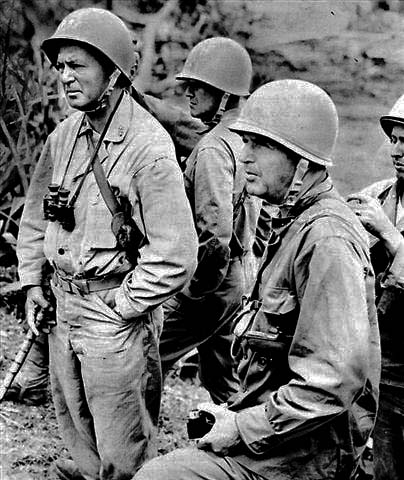
Despite the casualties, preparations were quickly underway for the long-anticipated invasion of Japan. All hands turned to in order to begin preparations to invade Kyushu. Already, Army Air Forces bomber groups that had been in Europe on V-E Day joined Marine Tactical Air Force units operating from Okinawa’s airfields and thousands of American, British and Canadian carrier-based aircraft in the pre-landing bombardment that was to lay waste to the southernmost Home Island before a contemplated October invasion was set in motion.
On July 2, 1945, while Marine and Army division rested, trained, and prepared for the expected invasion of mainland Japan, the first atomic bomb was tested in New Mexico. An alternative to the invasion was now a definite possibility. On the morning of August 6, 1945, an atomic bomb exploded over Hiroshima. Three days later, Nagasaki suffered a similar fate. A few days later the Japanese surrendered. No mainland invasion would take place; the fighting was over.
For a short video on the Sugar Loaf, please go to https://www.youtube.com/watch?v=t19rs7sQvfA

My father in law, Marine, Hugh Stringer was present with a Raider group. He was left behind enemy lines with Australian coast watchers for several weeks. I don’t know exactly where this was.
My father joined the US Marine Corps on June 25, 1941, and reported to the Marine Corps Recruit Training Depot, Parris Island, South Carolina for boot-camp training. He was assigned to Headquarters and Headquarters Company “C” Recruit Company. After completing boot camp on August 30, 1941, he received orders to report to the Marine Corps Barracks, 8th & “I” Street, Washington D.C. He served with the Marine Corps Drum and Bugle Corps – “The President Own” as a Trumpeter.
Sergeant Charles Earle Menges Jr.
My father
In 1945, he received orders to support the WWII Pacific Campaign. He was assigned to Company “D” 2nd Battalion, 29th Regiment, 6th Marine Division, as a Squad Leader. On 18 May 1945, he was wounded during the Battle for Sugar Loaf Hill, Okinawa. On 25 May 1945, a telegram was sent to both his mother and wife, noting his wounds. Also, on this date, he extended for a period of two years with the Marine Corps. On 19 July 1945, he was promoted to sergeant and attached to Company “G” 2nd Bn, 29th Marines, 6th Marine Division. After the war was over, my father was reassigned to “C” Company, 1st Battalion, 4th Marines, and served in Tsingtao, China from, 26 July 1945 to 10 July 1946.
My father’s combat action during WWII – Taking Sugar Loaf Hill, Okinawa
Looking back at the Battle for Sugar Loaf Hill, I remembered that the 6th Marine Division conducted an amphibious landing on the western side of the island and moved north to seek out the enemy. After operations in the north were completed, the 29th Marines headed south toward Naha. Once they reached the hilly part leading to Naha, all hell broke out.
As the battle continues, there was one fresh unused company of the 29th Marines, Dog (D) Company -that I was assigned to – and that had come in that morning under Captain Howard L. Mabie. However, one platoon under Lieutenant Murphy had already been committed on 15 May with the 2nd Battalion, /22nd Marines. Captain Mabie came up along the mauled and the torn road that lay close along Queen Ridge, up past that which one Battalion, 29th Marines had fought for and now held. He swung his company in behind Charlie Hill where Captain Meissner was and then got it into position on the edge of the valley facing Sugar Loaf. He and Captain Meissner consulted on the ways and means to assault the enemy.
This assault was in effect the last great climax of all that had gone before. If the hill could not be taken now, with the knowledge that we had gained and after we had killed a good many – 71 – of the defenders, it could be taken only by the expenditure of our last reserves, the 4th Marines.
Captain Mabie called his platoon leaders up to the OP and told them exactly what he proposed to do: the 1st platoon under Lieutenant F. X. Smith was to flank the hill, moving down the valley and up the western nose, peeling off fire teams as it went to keep a continuous line from base to top. When Lieutenant Smith had reached halfway to the top, the 2nd platoon under Platoon Sgt Ellison was to assault directly up the reverse slope with two squads in the attack in order to hold the left part of the hill. The 3rd platoon was to remain in reserve across the valley, ready with machine guns and rifles for protective fire.
After Captain Mable had briefed his platoon leaders, they in turn called up their squad leaders and pointed out to them exactly where they were to go. The squad leaders returned to their fire teams, got them in position, and explained what they were going to do. While all this was going on, the battalion FO, Lieutenant Snyder, was using the artillery. He pulled the shells back until they were firing a bare 300 yards in front of the forward slope of Sugar Loaf. Meanwhile, the 81mm’s were dropping their shells just over the crest. After a thunderous barrage, Mabie lifted the fires.
He had made arrangements with Captain More II of Able (A) Company, 6th Tank Battalion, to send three tanks down the railroad tracks and behind the hill, two tanks to protect the one tank ahead. The tanks waddled through the cut just in time to see the Japanese swarming out of their caves on the high terrace to repel an expected attack, and he killed scores of them very literally with the first blast of his gun. The tanks fired rapidly and then retired, the rear tanks shooting down two satchel teams as they dashed out of caves. As the tanks came back, they came upon a reeling figure that waved down to them from the gray torn earth at the foot of the hill. It was Lieutenant Green who had managed to crawl down from the edge of the hill to the railroad tracks and now feebly hailed them. His escape was something of a miracle.
As soon as the tanks came back, Captain Mabie opened up with a rocket barrage on the hill itself from the maximum range of 1200 yards. The trucks with their rocket racks had fired before from the corridor to the south of Queen Ridge, usually escaping from retaliatory artillery fire only by the narrowest of margins. The trucks came in over a saddle where they could be plainly seen. As soon as the first test rockets went up, the heavy shells began to fall. The twelve tracks bore a somewhat frantic resemblance to fire trucks as they dashed up, whirled about, and they started as fast as they could for the nearest defilade.
At the end of the rocket barrage, the artillery opened again, the signal for the assault. The company’s 60mm’s dropped their shells squarely on top of the hill till the troops started up. The attack took about 20 minutes. The two platoons reached the summit at about the same time and plunged forward, throwing grenades and emptying rifles and carbines. The tanks came out through the railroad cut in time to see the figures of men against the sky.
Sugar Loaf Hill, Okinawa – 1945
At about 0950 hours, Lieutenant Smith called Mabie on his 536 and told him to send up the PX supplies; the hill was ours. The men were under steady fire as they dug in, but the artillery had not been turned on the hill itself. The 3rd platoon and Company Headquarters carried up supplies, aided by Easy (E) Company. By noon all the wounded had been evacuated, and the men were firmly emplaced. The line ran across the military crest of the hill and down to the forward slope on either end, where a fire team dug in to prevent any envelopment or an approach from Horseshoe Ridge below Sugar Loaf.
Late in the afternoon Captain Fowler took Fox (F) Company, 29 Marines down past the western nose of Sugar Loaf and spread them out along the edge of the Horseshoe Ridge. There was fire coming from the valley below them, but they could dig into their positions along the crest. Captain Fowler knew there was one wrong spot: the defile at the very western end of the ridge where a road led down to Naha and a bridge across the Asato.
Note: For further information on US Marines in China, See: Marine Corps Historical Reference Pamphlet – The United States Marines in North China.
After his service in China, he returned to the United States on 14 August 1946, where he was re-assigned back to Marine Corps Barracks at “8” & “I” Street, Washington DC. At the barrack, he served as the “Sergeant of the Guard” and served in that position until his discharge from active service, on 27 May 1947.
The 6th Marine Division was formed in September 1944 and disbanded on April 1, 1946.
(Side Note): The 6th Marine Division Association held its last meeting in 2022 in Fredericksburg VA.
After his discharge, he worked as a carpenter, then as a Union Organizer for the Carpenters Union, until he was in medical retirement. The family was relocated at the end of 1950, to 8262 New Hampshire Avenue, Langley Park, Maryland, for the remainder of his life.
My father received the following awards for his service with the United States Marine Corps:
My Fathers’ Military Awards
6th Marine Division Patch
29th Marine Regiment Patch
Sergeant Rank & 4-Year Service Sleeve Patch
Ribbons and Shooting Badges
Purple Heart Medal
Good Conduct Medal
Asia-Pacific Ribbon
American Defense Service Ribbon
American Campaign Medal
Victory – World War II Medal
Presidential Unit Citation w/1star
China Service Medal
6th Marines Shoulder Lanyard
Personal Dog tags
The above information was extracted from My fathers’ Service Record Book, Pages 7, 8, 9, 11 & 23.